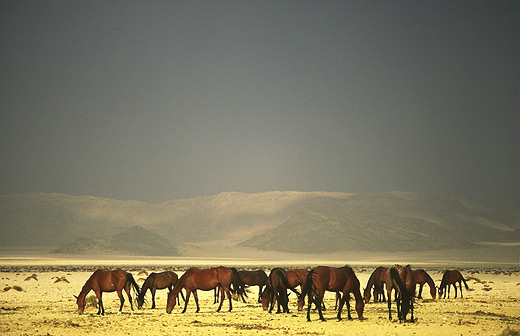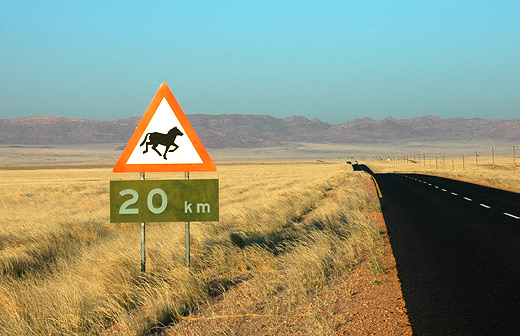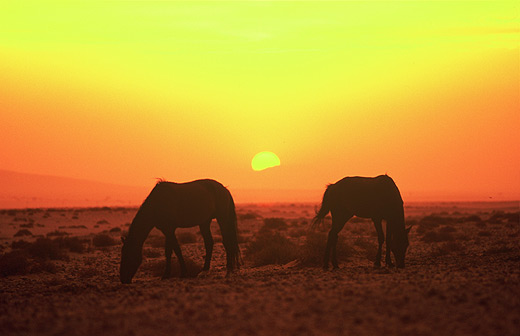The Namib Desert Horse
is a rare horse found in the Namib Desert in southern Namibia, Africa. It is most
likely the only feral herd of horses residing in Africa in harsh desert
conditions. Today, approximately
150 horses live in 350 square kilometres stretch of the Namib Desert en route
to Atlantic coast town Luderitz. The origin
of these animals is unclear, though several theories have been put forward.
Genetic tests have been performed, although none to date have completely
verified their origin.
History of Namib horses
Horses are not  native to Sub-Saharan Africa. The first horses in sub-Saharan
Africa were brought by the Dutch to the area of the Cape of Good Hope in the
17th century. There are several theories on how the Namib Desert Horse
originated: One theory says that a ship with horses on board was run aground; the strongest horses were able to swim ashore to the mouth of the
Orange River and up to the Garub Plains, where the modern herds live today.
native to Sub-Saharan Africa. The first horses in sub-Saharan
Africa were brought by the Dutch to the area of the Cape of Good Hope in the
17th century. There are several theories on how the Namib Desert Horse
originated: One theory says that a ship with horses on board was run aground; the strongest horses were able to swim ashore to the mouth of the
Orange River and up to the Garub Plains, where the modern herds live today.
There is also a theory that Namib Desert Horses are descendents of the horses
of the German Schutztruppe brought in during the 19th century. Others say they
are from Farm
Duwisib (south of Maltahöhe), owned by Baron Hansheinrich
von Wolf. Other sources suggest they came from imports in the 20th century,
between 1904 and the beginning of World War I, when the Germans brought 30,000
horses into the area. Others suggest that some of these horses' forebears
escaped from the South African cavalry during World War I.
Research in the archives of pre-1914 horse breeding operations found at
Windhoek, combined with blood typing studies suggests that the animals
descended from a gene pool of high-quality riding animals, as opposed to work
horses. A study released in 2005 suggests two likely source of these horses'
forebears. The first source was a stud farm near Kubub, owned by Emil Kreplin,
once mayor of Lüderitz from 1909 to 1914. In this period, Kreplin bred
both work horses and race horses. Photo albums from the stud show animals with
distinctive characteristics still seen in the Namib Desert Horse of today.
In addition, during World War I, at one point, the South African military was
advancing against the Schutztruppe, then located in the Namib near Aus, when
the pilot of a German biplane dropped bombs onto the South African camp near
Garub. In the process, some ordinance landed among a herd of 1,700 grazing
horses. These escaped army animals may have joined stock animals lost from
Kreplin's stud farm during the turmoil of the war. Horses in the area would
likely have congregated at the few existing watering places in the Aus
Mountains and Garub.
Regardless of origins, after 100 years there were only 200 horses left in the
deserts, but those that survived had adapted to the conditions of the South
Namib Desert.
The Namib desert horses were originally forced to compete with domesticated
livestock turned loose by farmers onto the same ground where the horses
grazed. Due in part to this competition for limited forage, the horses nearly
became extinct. However, they were saved in part due to the efforts of Jan
Coetzer, employee of Consolidated Diamond Mine (CDM or DBCM), mining in a
certain part of
Sperrgebiet. Coetzer was fond of horses and made sure they
always had water at the Garub windmill, put there as a permanent water tank by
CDM. Later, the horses' habitat was made part of Namib-Naukluft Park in the
late 1980s. The park was headed by Chris Eyre, head of the Nature
Conservation.
Characteristics
of Namib horses
The Namib Desert Horses are athletic, muscular, clean limbed, and are very
strong boned. They are short backed with oblique shoulders and good withers.
The horses have the appearance of well bred riding horses in head, skin, and
coat.
The Namib desert horse must eat while on the move. When grazing, they only
stay in one spot for a short time. They must cover considerable distances, as
much as 15 to 20 kilometres (9 to 12 mi) between the few existing water
sources and the best grazing sources. Due to scarcity of water, the Namib
desert horse sometimes has to go without water for as long as thirty hours in
summer and has been known to go close to 72 hours without water during the
winter. As a consequence, Namib Desert Horses are considered very hardy.
Due to the distances they must travel and the scarcity of water, selection
pressure is severe, and weak animals do not survive.
is severe, and weak animals do not survive.
The most common color of the Namib desert horse is bay, although there are a
few chestnut horses. There are occasional individuals with dorsal striping but
no zebra stripes. No other colors have been recorded.
Genetics
Genetic testing results published in 2001 indicated that Namib Desert Horses
are one of the most isolated horse populations in the world, with the
second-lowest genetic variation of all horse populations that have been
studied to date. In part, this is due to their small founding population, and
generally small modern population, made smaller during periods of drought.
On Cothran's Family Tree of Horse breeds, they fall in the Arabian group,
nearest the Shagya Arabian, a horse breed from Hungary that had been imported
into colonial German South-West Africa. However, though the horses have a
genetic similarity to Arabian-type horses, they do not closely resemble them
in outward appearance.
Further, in blood typing studies done in the 1990s,
a new variant was noted. Its absence from the blood samples of all other horse
breeds indicates the presence of a mutation that probably occurred after the
horses became established in the desert.
Daily life
The Namib desert horse usually live in herds of up to ten animals, consisting
of one or, occasionally, two stallions with a few mares and foals. These are
the breeding groups. There are also 'bachelor' groups. The breeding groups are
led by a mare. The lead mare decides when to go, stop, choose another grazing
spot, and when to go to a water source.
There are few natural predators in the area, other than the Hyena, which poses
a threat primarily to foals. When a foal is threatened, it is usually the mare
that is the mother of the foal who defends her young. The stallion will deal
with threats to the entire herd, though in many cases, the stallion primarily
keeps bachelor animals away. There are few serious fights, most are for show.
Contact & information:
E-mail: info@namibweb.com



Page created and serviced by

www.namibweb.com
Copyright © 1998-2025
namibweb.com - The online guide
to Namibia
All rights reserved |
JOIN
|
VIDEO PORTFOLIO
|
VIDEO/PHOTO COLLECTION
Telegram
| YouTube |
Blog
Page is sponsored by ETS &
Exploring Namibia TV
Disclaimer: no matter how often this page is updated and its accuracy is checked,
www.namibweb.com and ETS
will not be held
responsible for any change in opinion, information, facilities, services,
conditions, etc. offered by
establishment/operator/service/information provider or any third party
 native to Sub-Saharan Africa. The first horses in sub-Saharan
Africa were brought by the Dutch to the area of the Cape of Good Hope in the
17th century. There are several theories on how the Namib Desert Horse
originated: One theory says that a ship with horses on board was run aground; the strongest horses were able to swim ashore to the mouth of the
Orange River and up to the Garub Plains, where the modern herds live today.
native to Sub-Saharan Africa. The first horses in sub-Saharan
Africa were brought by the Dutch to the area of the Cape of Good Hope in the
17th century. There are several theories on how the Namib Desert Horse
originated: One theory says that a ship with horses on board was run aground; the strongest horses were able to swim ashore to the mouth of the
Orange River and up to the Garub Plains, where the modern herds live today.
 is severe, and weak animals do not survive.
is severe, and weak animals do not survive.